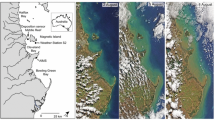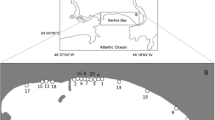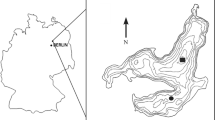Abstract
A simple and inexpensive sampler to measure bedload sediment transport in shallow subtidal or intertidal areas is described. The cylindrical sub-sediment trap with an aspect ratio of 20 (height: diameter) is an improvement over conventional bedload samplers which are difficult to use in shallow areas or fail to collect the biological material associated with bedload. Traps deployed on a low-energy intertidal sandflat for six months provided daily estimates of bedload transport (quartz grains: 0.001–40 kg m−1 d−1), passive infaunal transport (e.g., the bivalveMya arenaria, max: 800 ind m−1 d−1), and organic detrital flux (e.g., macrophyte fragments, max: 400 g dry wt m−1 d−1). Bedload rates estimated with traps were compared to predictions from a numerical bedload model to evaluate the trap’s collection and retention efficiency. A significant linear regression between observed (trap) and predicted (model) rates (r2=0.65, p<0.001, n=97) indicated that the traps were useful for the measurement of high- and low-frequency variability in bedload transport. Potential applications of the traps in benthic oceanography include recruitment and recolonization studies.
Similar content being viewed by others
Literature Cited
Amos, C. L., A. J. Bowen, D. A. Huntley, andC. F. M. Lewis. 1988. Ripple generation under the combined influence of waves and currents on the Canadian continental shelf.Continental Shelf Research 8:1129–1153.
Anderson, F. E., L. Black, L. E. Watling, W. Mook, andL. M. Mayer. 1981. A temporal and spatial study of mudflat erosion and deposition.Journal of Sedimentary Petrology 51: 729–736.
Baker, E. T., H. B. Milburn, andD. A. Tennant. 1988. Field assessment of sediment trap efficiency under varying flow conditions.Journal of Marine Research 46:573–592.
Bloesch, J. andN. Burns. 1980. A critical review of sedimentation trap technique.Schweizerische Zeitschrift für Hydrologie 42:15–55.
Blomqvist, S. andL. Håkanson. 1981. A review on sediment traps in aquatic environments.Archiv für Hydrobiologie 91: 101–132.
Boucot, A. J. 1981. Principles of Benthic Marine Paleoecology. Academic Press, New York. 463 p.
Butman, C. A. 1986. Sediment trap biases in turbulent flows: Results from a laboratory flume study.Journal of Marine Research 44:645–693.
Commito, J. A. 1982. Effects ofLunatia heros predation on the population dynamics ofMya arenaria andMacoma balthica in Maine, USA.Marine Biology 69:187–193.
Dyer, K. R. 1986. Coastal and Estuarine Sediment Dynamics. John Wiley and Sons, Chichester. 142 p.
Emerson, C. W. 1989. Wind stress limitation of benthic secondary production in shallow, soft-sediment communities.Marine Ecology Progress Series 53:65–77.
Emerson, C. W., T. E. Minchinton, andJ. Grant. 1988. Population structure, biomass, and respiration ofMya arenaria L. on a temperate sandflat.Journal of Experimental Marine Biology and Ecology 115:99–111.
Fairweather, P. G. 1988. Consequences of supply-side ecology: Manipulating the recruitment of intertidal barnacles affects the intensity of predation upon them.Biological Bulletin 175:349–354.
Gardner, W. D. 1980. Field assessment of sediment traps.Journal of Marine Research 38:41–52.
Gordon, D. C., Jr. andC. Desplanque. 1983. Dynamics and environmental effects of ice in the Cumberland Basin in the Bay of Fundy.Canadian Journal of Fisheries and Aquatic Sciences 40:1331–1342.
Grant, J. 1981. Sediment transport and disturbance on an intertidal sandflat: Infaunal distribution and recolonization.Marine Ecology Progress Series 6:249–255.
Grant, J. 1983. The relative magnitude of biological and physical sediment reworking in an intertidal community.Journal of Marine Research 41:673–689.
Grant, J. 1985. A method for measuring horizontal transport of organic carbon over sediments.Canadian Journal of Fisheries and Aquatic Sciences 42:595–602.
Grant, J. 1986. Sensitivity of benthic community respiration and primary production to changes in temperature and light.Marine Biology 90:299–306.
Grant, J. 1988. Intertidal bedforms, sediment transport, and stabilization by benthic microalgae, p. 499–510.In P. L. de Boer, A. van Gelder, and S. D. Nio (eds.), Tide-Influenced Sedimentary Environments and Facies. D. Reidel Publishing Company, Boston, Massachusetts.
Grant, J., U. V. Bathmann, andE. L. Mills. 1986a. The interaction between benthic diatom films and sediment transport.Estuarine, Coastal and Shelf Science 23:225–238.
Grant, J., E. L. Mills, andC. M. Hopper. 1986b. A chlorophyll budget of the sediment-water interface and the effect of stabilizing biofilms on particle fluxes.Ophelia 26:207–219.
Grant, J., C. T. Enright, andA. Griswold. 1990. Resuspension and growth ofOstrea edulis: A field experiment.Marine Biology 104:51–59.
Guza, R. T. andE. B. Thornton. 1985. Observations of surf beat.Journal of Geophysical Research 90:3161–3172.
Håkanson, L., S. Floderus, andM. Wallen. 1989. Sediment trap assemblages—A methodological description.Hydrobiologia 176/177:481–490.
Hargrave, B. T. andG. A. Phillips. 1981. Annual in situ carbon dioxide and oxygen flux across a subtidal marine sediment.Estuarine, Coastal and Shelf Science 12:725–737.
Hasselmann, K., T. P. Barnett, E. Bouws, H. Carlson, D. E. Cartwright, K. Enke, J. A. Ewing, H. Gienapp, D. E. Hasselmann, P. Kruseman, A. Meerburg, P. Muller, D. J. Olbers, K. Richter, W. Sell, andH. Walden. 1973. Measurements of wind wave growth, swell and decay during the Joint North Sea Wave Project (JONSWAP).Deutsche hydrographische Zeitschrift 12:1–95.
Hawkes, P. J. 1987. A wave hindcasting model, p. 73–88.In Advances in Underwater Technology, Ocean Science and Offshore Engineering. Volume 12, Modelling the Offshore Environment. Graham and Trotman Inc., Norwell, Massachusetts.
Hubbell, D. W., H. H. Stevens, Jr.,J. V. Skinner, andJ. P. Beverage. 1985. New approach to calibrating bed load samplers.Journal of Hydraulic Engineering 111:677–694.
Jumars, P. A. andA. R. M. Nowell. 1984. Effects of benthos on sediment transport: Difficulties with functional grouping.Continental Shelf Research 3:115–130.
Jumars, P. A. andR. F. L. Self. 1986. Gut-marker and gutfullness methods for estimating field and laboratory effects of sediment transport on ingestion rates of deposit-feeders.Journal of Experimental Marine Biology and Ecology 98:293–310.
Kachel, N. B. andR. W. Sternberg. 1971. Transport of bedload as ripples during an ebb current.Marine Geology 10: 229–244.
King, D. B., Jr. andR. J. Seymour. 1989. State of the art in oscillatory sediment transport models, p. 371–385.In R. J. Seymour (ed.), Nearshore Sediment Transport. Plenum Press, New York.
Komar, P. D. andM. C. Miller. 1975. On the comparison between the threshold of sediment motion under waves and unidirectional currents with a discussion of the practical evaluation of the threshold.Journal of Sedimentary Petrology 45: 362–367.
Landahl, J. 1988. Sediment-level fluctuation in a mussel bed on a ‘protected’ sand-gravel beach.Estuarine, Coastal and Shelf Science 26:255–267.
Lee, C., S. G. Wakeham, andJ. I. Hedges. 1988. The measurement of oceanic particle flux—Are “swimmers” a problem?Oceanography 1:34–36.
Leeder, M. R. 1982. Sedimentology. George Allen & Unwin (Publishers) Ltd., London. 344 p.
Lowe, R. 1989. Measuring sediment dynamics. B. Continuous bedload sampling, p. 91–93.In R. J. Seymour (ed.), Nearshore Sediment Transport. Plenum Press, New York.
Luckenbach, M. W., D. V. Huggett, andE. C. Zobrist. 1988. Sediment transport, biotic modifications, and selection of grain size in a surface deposit-feeder.Estuaries 11:134–139.
Ludwick, J. C. 1989. Bed load transport of sand mixtures in estuaries: A review.Journal of Geophysical Research 94:14315–14326.
Medcof, J. C. 1950. Burrowing habits and movements of soft-shelled clams.Fisheries Research Board of Canada, Progress Report of the Atlantic Coast Stations 50:17–21.
Miller, D. C. 1989. Abrasion effects on microbes in sandy sediments.Marine Ecology Progress Series 55:73–82.
Miller, D. C. andR. W. Sternberg. 1988. Field measurements of the fluid and sediment-dynamic environment of a benthic deposit feeder.Journal of Marine Research 46:771–796.
Miller, D. C., P. A. Jumars, andA. R. M. Nowell. 1984. Effects of sediment transport on deposit feeding: Scaling arguments.Limnology and Oceanography 29:1202–1217.
Murphy, P. J. andM. I. Amin. 1979. Compartmented sediment trap.Journal of the Hydraulics Division, Proceedings of the American Society of Civil Engineering 105:489–500.
Nickling, W. G. 1988. The initiation of particle movement by wind.Sedimentology 35:499–511.
Palmer, M. A. 1988. Dispersal of marine meiofauna: A review and conceptual model explaining passive transport and active emergence with implications for recruitment.Marine Ecology Progress Series 48:81–91.
Pattiaratchi, C. B. andM. B. Collins. 1984. Sediment transport under waves and tidal currents: A case study from the northern Bristol Channel, U.K..Marine Geology 56:27–40.
Pattiaratchi, C. B. andM. B. Collins. 1985. Sand transport under the combined influence of waves and tidal currents: An assessment of available formulae.Marine Geology 67:83–100.
Peterson, C. H. 1986. Enhancement ofMercenaria mercenaria densities in seagrass beds: Is pattern fixed during settlement season or altered by subsequent differential survival?Limnology and Oceanography 31:200–205.
Rhoads, D. C. andD. K. Young. 1970. The influence of deposit-feeding organisms on sediment stability and community trophic structure.Journal of Marine Research 28:150–178.
Rosati, J. D. and N. C. Kraus. 1989. Development of a portable sand trap for use in the nearshore. United States Army Corps of Engineering, Surf Zone Sediment Transport Processes, Work Unit 34321, Technical Report CERC-89-11. 109 p.
Sauzay, G. 1973. Tracer techniques in sediment transport: Report of the panel, p. 3–8.In Tracer Techniques in Sediment Transport, Technical Reports Series No. 145. International Atomic Energy Agency, Vienna, Austria.
Savidge, W. B. andG. L. Taghon. 1988. Passive and active components of colonization following two types of disturbance on intertidal sandflat.Journal of Experimental Marine Biology and Ecology 115:137–155.
Sleath, J. F. A. 1982a. Friction coefficients of rippled beds in oscillatory flow.Continental Shelf Research 1:33–47.
Sleath, J. F. A. 1982b. The suspension of sand by waves.Journal of Hydraulic Research 77:39–55.
St. Denis, M. 1969. On wind generated waves, p. 3–44.In C. L. Bretschneider (ed.), Topics in Ocean Engineering. Gulf Publishing Co., Houston, Texas.
Vincent, C. E., R. A. Young, andD. J. P. Swift. 1982. On the relationship between bedload and suspended sand transport on the inner shelf, Long Island, New York.Journal of Geophysical Research 37:4163–4170.
Wilkinson, L. 1988. SYSTAT: The System for Statistics. SYSTAT Inc., Evanston, IL. 822 p.
Williams, J. J., P. D. Thorne, andA. D. Heathershaw. 1989. Comparisons between acoustic measurements and predictions of the bedload transport of marine gavels.Sedimentology 26:973–979.
Zwarts, L. andJ. Wanink. 1989. Siphon size and burying depth in deposit- and suspension-feeding benthic bivalves.Marine Biology 100:227–240.
Author information
Authors and Affiliations
Rights and permissions
About this article
Cite this article
Emerson, C.W. A method for the measurement of bedload sediment transport and passive faunal transport on intertidal sandflats. Estuaries 14, 361–371 (1991). https://doi.org/10.2307/1352261
Received:
Accepted:
Issue Date:
DOI: https://doi.org/10.2307/1352261




